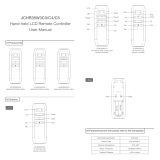
2 TASCAM SX-1 Reference Manual
TASCAM
Software License Agreement
THIS SOFTWARE LICENSE AGREEMENT
(“LICENSE”) IS
AN AGREEMENT BETWEEN
YOU AND TASCAM, ADIVISION OF TEAC
AMERICA INC. (“TASCAM”). TASCAM IS
WILLING TO LICENSE THE ENCLOSED SOFT-
WARE TO YOU ONLY UPON THE CONDITION
THAT YOU ACCEPT ALL OF THE TERMS CON-
TAINED IN THIS LICENSE. PLEASE READ THIS
LICENSE CAREFULLY BEFORE USING THE
SOFTWARE. BY USING THE SOFTWARE YOU
INDICATE THAT YOU AGREE TO BE BOUND
BY THE TERMS OF THIS LICENSE. IF YOU DO
NOT AGREE TO THE TERMS OF THIS
LICENSE, TASCAM IS UNWILLING TO
LICENSE THE SOFTWARE TO YOU, AND YOU
SHOULD PROMPTLY RETURN THE UNUSED
SOFTWARE TO THE PLACE WHERE YOU
OBTAINED IT FOR A REFUND.
1. Grant of License.
The application, system and all
other software accompanying this License, whether
on CD-ROM or any other media (the “Software”),
and the related documentation, are licensed to you by
TASCAM solely for your own internal purposes, and
only as described in the documentation, on a single
compatible microcomputer. If the Software is to be
used on two or more microcomputers, a separate
license must be obtained. Use on a network is not
permitted. If this Software is an upgrade to a prior
version, then you must be licensed to use the prior
version of the Software in order to exercise the
license rights granted hereunder, and you may only
use the prior version or the upgrade but not both.
2. Restrictions. The Software
contains copyrighted
material, trade secrets, and other proprietary material
of TASCAM and its licensors. You agree that in
order to protect those proprietary materials, you will
not decompile, reverse engineer, disassemble or oth-
erwise reduce all or any part of the Software to
human-readable form. You may not modify, rent,
lease, loan, sub-license, distribute or create deriva-
tive works based upon the Software in whole or in
part. You may not copy the Software except to make
one additional copy of the Software in the form in
which it is provided to you, only for backup purposes
and provided you reproduce on such copy the TAS-
CAM copyright notices and any other proprietary
legends that are on the original copy of the Software.
You may copy the documentation solely for your per-
sonal use. You may transfer the Software and related
documentation, and all your license rights thereto, to
another party by transferring to that party both the
original media on which the Software and related
documentation were provided and a copy of this
License, and provided that the other party reads and
agrees to accept the terms and conditions of this
License. Immediately upon transfer, you have no fur-
ther rights to use or own copies of the Software or
related documentation and must destroy all copies in
your possession or control. any transfer of the Soft-
ware must include all prior versions of the Software.
3. Ownership.
The Software and documentation are
licensed, not sold, to you for use only under the terms
of this License, and TASCAM reserves all rights not
expressly granted to you in this License. You own the
media on which the Software and documentation are
recorded but TASCAM and/or TASCAM's licensors
retain title to and ownership of the Software and
related documentation, and all intellectual property
rights therein, including, without limitation, copy-
right, patent rights and trade secrets.
4. Termination. This License
is effective until termi-
nated. You may terminate this License at any time by
destroying all copies of the Software and related doc-
umentation in your possession or control. This
License will terminate immediately without notice
from TASCAM if you fail to comply with any provi-
sion of this License. Upon termination you must
destroy all copies of the Software and related docu-
mentation in your possession or control.
5. Export Law Assurances. Y
ou agree and certify
that neither the Software nor any other technical data
received from TASCAM will be exported outside the
United States except as authorized and as permitted
by the laws and regulations of the United States. If
the Software has been rightfully obtained by you out-
side of the United States, you agree that you will not
re-export the Software nor any other technical data
received from TASCAM except as permitted by the
laws and regulations of the United States and the
laws and regulations of the jurisdiction in which you
obtained the Software.
6. Government End Users. If you are
acquiring the
Software on behalf of any unit or agency of the
United States Government, the following provisions
apply. The Software constitutes a “commercial item”,
as that term is defined at 48 C.F.R. 2.101, consisting
of “commercial computer software” and “commer-
cial computer software documentation”, as such





















